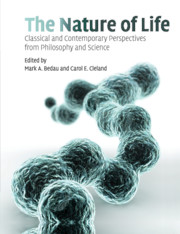Book contents
- Frontmatter
- Contents
- Preface
- Acknowledgments
- Sources
- About the authors
- Introduction
- SECTION I CLASSICAL DISCUSSIONS OF LIFE
- SECTION II THE ORIGIN AND EXTENT OF NATURAL LIFE
- SECTION III ARTIFICIAL LIFE AND SYNTHETIC BIOLOGY
- 16 Learning from functionalism: prospects for strong artificial life
- 17 Life, “artificial life,” and scientific explanation
- 18 Alien life: how would we know?
- 19 Automatic design and manufacture of robotic life forms
- 20 A giant step towards artificial life?
- 21 Approaches to semi-synthetic minimal cells: a review
- 22 Creating “real life”
- SECTION IV DEFINING AND EXPLAINING LIFE
- Supplementary bibliography on life
- Index
- References
17 - Life, “artificial life,” and scientific explanation
Published online by Cambridge University Press: 10 November 2010
- Frontmatter
- Contents
- Preface
- Acknowledgments
- Sources
- About the authors
- Introduction
- SECTION I CLASSICAL DISCUSSIONS OF LIFE
- SECTION II THE ORIGIN AND EXTENT OF NATURAL LIFE
- SECTION III ARTIFICIAL LIFE AND SYNTHETIC BIOLOGY
- 16 Learning from functionalism: prospects for strong artificial life
- 17 Life, “artificial life,” and scientific explanation
- 18 Alien life: how would we know?
- 19 Automatic design and manufacture of robotic life forms
- 20 A giant step towards artificial life?
- 21 Approaches to semi-synthetic minimal cells: a review
- 22 Creating “real life”
- SECTION IV DEFINING AND EXPLAINING LIFE
- Supplementary bibliography on life
- Index
- References
Summary
INTRODUCTION
What is it for an entity to be a living thing? This question has recently been treated with benign neglect by philosophers. (It goes entirely unmentioned in current philosophy of biology texts—e.g., Rosenberg 1985; Sober 1993.) In contrast, it is now being much discussed by certain biologists and computer scientists. They deny that the distinction between life and nonlife is an artificial one; on their view, it is an important subject for scientific investigation. They have organized themselves into a new field, “artificial life,” with its own conferences (e.g., Langton 1989; Langton et al. 1991), its own journal (Volume 1 of Artificial Life, dated 1994, has been published by MIT Press), and even its own popularizations (e.g., Levy 1992; Emmeche 1994).
“Alife” researchers believe that it is possible to create and to study digital organisms, each of which consists of a machine-language program living in a computer's memory. When the program is executed, it is sometimes copied to another location in memory. The program can arrange for its “copy” to include certain new elements, permitting variation and selection to occur. “Evolving digital organisms will compete for access to the limited resources of memory space and CPU time, and evolution will generate adaptations for the more agile access to and the more efficient use of these resources” (Ray 1994, p. 185).
- Type
- Chapter
- Information
- The Nature of LifeClassical and Contemporary Perspectives from Philosophy and Science, pp. 236 - 248Publisher: Cambridge University PressPrint publication year: 2010
References
- 1
- Cited by



